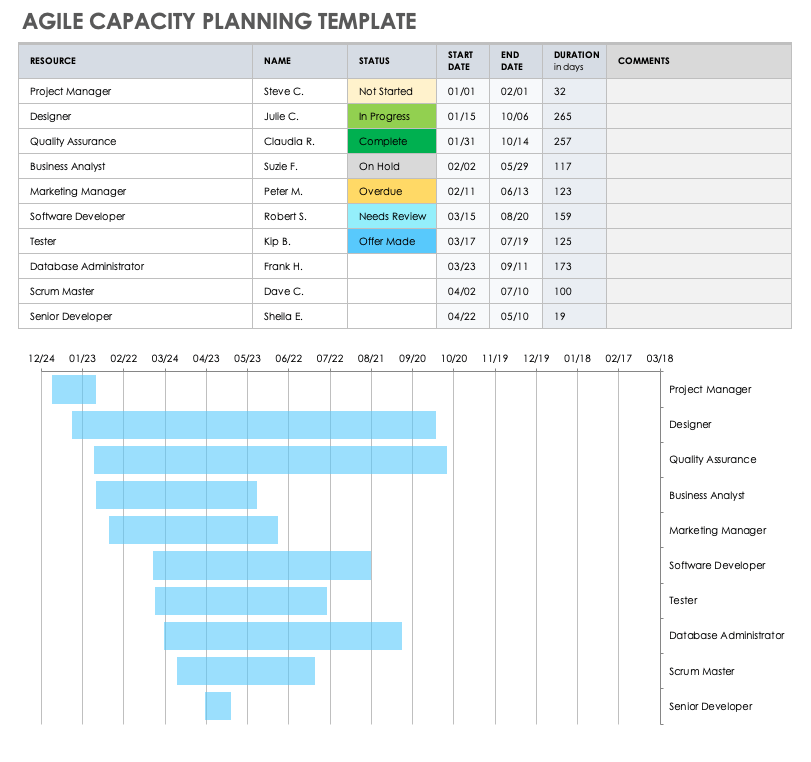What Is Capacity Planning in Agile?
Agile capacity planning is a part of the Agile planning process, in which you calculate the capacity of your Agile team. Capacity planning helps the team understand the amount of productive engineering time available in a sprint.
For example, to perform capacity planning for an Agile team, you must gather each team member's availability and time off, and then add up the individual capacities to calculate the team’s overall capacity. Also, you’ll need to account for the duration of the sprint, any backlog items, the standard number of hours worked in a day, and competing priorities in order to properly assess capacity. This process allows the team to confidently commit to productive work within the sprint.
The terms IT capacity management and ITIL capacity and performance management refer to a similar process for IT teams. Both approaches help ensure that IT resources are sufficient to meet future business needs.
When Should You Do Agile Capacity Planning?
Agile capacity planning takes place before a sprint planning meeting. This practice is also known as commitment-based sprint planning or capacity-based sprint planning.
Who Participates in Sprint Capacity Planning?
The sprint capacity planning meeting involves the product owner, the Scrum master, and any appropriate development team members. The meeting should last no more than 30 minutes; in some cases, capacity planning can occur without an in-person meeting.
What Is Team Capacity in Scrum?
The Scrum framework aims to improve team cooperation, but Scrum teams sometimes face challenges when they overcommit in a sprint. Commitment-driven planning or Agile capacity planning ensures that you have enough capacity to complete tasks without overcommitting.
What Is the Difference between Team Velocity and Team Capacity in Agile?
Velocity measures the average number of story points or tasks that an Agile team can deliver per sprint in a given time frame. Team capacity refers to the number of development hours available for a sprint.
How Is Capacity Calculated in Agile?
Agile uses two methods for capacity planning: velocity planning, which uses story points, and capacity planning, which calculates hours of available engineering time. Below you will find details on how to calculate capacity in story points and hours of availability.
How Do You Calculate Capacity Using Story Points?
To calculate capacity using story points, velocity-driven sprint planning assumes consistent team size, similar work across sprints, and consistent sprint lengths.
As Shai Shandil, Founder and CEO of softsolutions suggests, “Some more mature teams may elect to use story points as their unit of measurement (instead of hours). There are various reasons for this, but the mathematics is the same. The only change is that the team will input the velocity as their capacity, not the number of hours they work. Their velocity is usually an average of points’ worth of work they have completed in recent sprints.”
Alan Zucker, Founding Principal at Project Management Essentials, LLC, sets the context on why Agile teams use capacity planning: “Traditional projects estimate task durations in days or hours. The project schedule is developed by aggregating the amount of time it will take to complete the work. But both experience and data show that these traditional estimating methods are not effective. Only about one-third of projects are completed on time, under budget, and with the intended scope. The average project is about 75 percent over budget.
“Agile takes a different approach,” Zucker continues. “Teams deliver new functionality in fixed duration iterations or sprints that are frequently two weeks long. Teams estimate their capacity (how much work they can complete during the sprint), the effort required to complete the user stories. At the beginning of the iteration, there is a short planning meeting in which the team matches the work that it can accomplish with its capacity. It is like filling a bucket: Teams take work from the backlog and pour it into the bucket until it is filled.”
Rather than estimating capacity and work in hours, Zucker recommends that teams use story points based on the Fibonacci sequence. “We have found that people can quickly estimate the relative size of different bodies of work. In other words, ‘This story is two, three, or five times bigger or more complex than that one.”
Zucker advises against comparing story points across teams, because doing so only promotes a type of grade inflation. “Story points are unique to a team. Every team will develop its internal process of estimating size. The best way to estimate a team’s capacity is based on its historical performance. In other words, how many story points they completed in the last several iterations. Capacity estimates for an upcoming iteration should be adjusted for known events, such as holidays, team vacations, or an upcoming training. For example, if our Agile team has 10 members, the sprint duration is 10 days. The number of story points the team completed each sprint is 100. If the sprint included a one-day holiday, the team would reduce its capacity by 10 points for that sprint. If team members were taking additional days off, the capacity would be adjusted accordingly.”
How Do You Calculate Capacity-Based Sprint Planning in Hours?
Capacity-based sprint planning relies on an estimate of hours to complete each backlog item. With the hours of engineering capacity in mind, the team will select tasks that fit in the sprint.
Follow the steps below to calculate capacity-based sprint planning:
- Calculate Team Member Availability: The first step is to calculate the productive engineering hours available.
- Calculate Sprint Duration: It’s essential that you know the number of days allocated to each sprint.
- Calculate Standard Hours per Day: This figure includes the number of hours worked each day.
- Consider Other Availability Factors: You need to account for holidays, vacations, shutdowns, and other factors that impact work hours during the planning process.
- Identify Other Work: Consider other projects and priorities that will take engineers away from productive sprint work.
- Calculate the Focus Factor: The focus factor is the actual percentage of each day that the team can focus on the sprint goals without interruption.
Capacity-Based Sprint Planning Examples
In this section, you will find three examples of capacity planning. The first is a real-life example that will resonate with anyone with a busy schedule, and the second and third illustrate Agile capacity planning in action.
“Imagine you’re going on a trip to New York City for the first time, and you have a list of 20 different places you want to see, 15 experiences you want to have, and 10 restaurants you want to try, but you’re only going for five days. It’s physically impossible for you to do everything on your list, so you have to prioritize and make trade-offs,” shares Saahil Panikar, an advisor at Project & Team.
Panikar continues, “you know that riding the Staten Island Ferry is going to take at least two hours to make the round trip and none of the restaurants you want to eat at are close to the port, so you deprioritize that. You also know that you can walk through Central Park, have a New York bagel, and watch a street performer simultaneously, so you prioritize those items. You have now built your trip to complete your top-priority items. Capacity planning is all about recognizing the limits on your time (or your team’s time) and maximizing the value you get in return.”
Shandil shares a similar capacity planning scenario for a Scrum team: “The most widely used capacity planning event is the sprint planning ceremony for Scrum teams,” he says. “Scrum teams will regularly host ceremonies to estimate the number of hours (or points) it will take to complete user stories or tasks, and stack-rank tasks in priority order. When the sum of all estimations equals the capacity (or velocity) of that team, the planning session is complete.”
Shandil also shares the following practical example of a three-person, 40-hour workweek team:
“If we have three people on our team, all of whom work a 40-hour week, and we are planning for a two-week sprint, the capacity is 240 hours: 3 x 40 x 2 weeks = 240 hours of capacity.”
The team will then look at all the tasks, allocate time, and determine what is feasible. “The team uses an estimation technique to estimate the five to-dos on their list,” as shown below:
- Task 1 – 50 hours
- Task 2 – 80 hours
- Task 3 – 60 hours
- Task 4 – 70 hours
- Task 5 – 40 hours
“You notice that the estimate for task four exceeds the team’s capacity. In this case, the team will push task four, but take on task five to keep the sprint within capacity. The work now totals 230 hours.”
Sergii Zhuravel, a lead software engineer at Absio, shares an example of Agile capacity planning calculation. “Let's imagine that we have a team of five people working for eight hours per day for a two-week sprint (10 days). First, we calculate the total capacity of the team [using this formula].”
Number of Team Members * Time (hours) * Days = Team’s Total Capacity
5 * 8 * 10 = 400 hours
Zhuravel continues, “The problem here is that relying on total time may burn out the team, lead to hastened and low-quality work, and lower team satisfaction. A better way to identify real capacity is to use the focus factor. Using a focus factor to calculate capacity helps ensure you calculate the team’s true capacity for focus without distractions. In this example, the range for the focus factor is 0.6 - 0.8. The real capacity for the sprint will be 400 * 0.8 = 320 hours.”
Agile Capacity Planning Template
Download Agile Capacity Planning Template
Microsoft Excel | Google Sheets
Use this comprehensive capacity planning template to calculate work capacity, effective capacity, and the time associated with development tasks. Start by filling in the total number of employees, working hours, and utilization rate, and then list the number of hours required for each project. The capacity plan dashboard will automatically calculate the total demand, effective capacity, and resource deficiency.
Visit our roundup of additional Agile capacity planning and management templates to flesh out your planning activities.
Tips for Capacity-Based Sprint Planning
In this section, Agile experts provide their tips for capacity-based sprint planning. These tips will help you plan for your next sprint, from keeping planning activities simple to preparing for unplanned interruptions.
Shandil provides two tips for getting started with capacity-based sprint planning: “Keep it simple, and don’t worry about perfect accuracy as you get started. The idea here is for the team to own the estimates and increase accuracy as you progress. Secondly, try to keep capacity the same from sprint to sprint – doing so helps with the learning curve.”
Zhuravel provides a helpful tip for applying a focus factor value. He suggests that teams “use a lower focus factor — say, 0.6 — when you have a less experienced team.”
When estimating team capacity to deliver new features, it is essential to consider the impact of the other things that consume a team’s time. “The team’s capacity should be adjusted for unplanned work,” suggests Zucker. “Unplanned work is everything that comes up other than the work on the product backlog. Unplanned work can be all-hands meetings, fire drills from the boss, or supporting production issues — in other words, all of the normal stuff that takes away from our productive hours. Our hypothetical may have 100 points of capacity without disruptions, but they plan for disruptions and set their capacity at 90 points.”
Zucker also emphasizes that capacity and story points are unique to a single team. “Do not compare capacity or story points across teams. Comparing team results is grade inflation and weaponizing the process. For example, consider that Team A’s capacity is 100 points, and Team B’s capacity is 200. If we tell Team A they are only half as good as Team B, they can double or triple their estimates. To avoid grade inflation, impose the rule that the team can not expect to deliver more capacity in the coming sprint than it has delivered in a recent sprint.”
What Is the Output of Capacity-Based Sprint Planning?
The output of capacity-based sprint planning goes beyond defining the capacity of the development team. The purpose is to determine the backlog items the team will deliver in the sprint. Careful thought is given to the available team capacity.
The Benefits and Importance of Agile Capacity Planning
Agile capacity planning helps Agile teams to accurately commit to and complete tasks. Quality planning results in better anticipation of resource time and skill challenges.
Below are the top benefits of Agile capacity planning:
- Improved Evidence-Based Forecasting: According to Shandil, “Agile capacity planning allows Agile teams to do what they do best — learn from past mistakes or errors in estimations, and apply those learnings immediately to the new sprint. Eventually, forecasting will lead to an actionable level of predictability for leaders.”
- Heightened Predictability: “The whole software world has been plagued by overruns in budget, delays in delivery, and atrocious quality,” says Shandil. “This is because as a profession, we have not found a way to forecast large bodies of work. Capacity planning in an Agile way fixes this issue. Yes, it’s unpredictable early in a team’s journey, but soon enough, teams will learn from their missteps and take actions to move toward predictability.”
- Improved Team Morale: “Effective capacity planning is so important for an Agile team to remain healthy and function continuously. When you have an organization that honors and respects a team that says, ‘We’re at capacity, what do you want us to remove if you want us to take that new work on?’ you have an organization that’s saying, ‘We see you as more than just a disposable resource to our business, and we want to give you the environment to be as successful as you can be,’” shares Panikar. “This attitude generates loyalty and inspires people to do their best all the time.”
- Increased Trust:
“Trust is the most significant benefit to capacity planning. The conversations build relationships between the business and development that create empathy on both sides,” shares Harry Koehnemann, a SAFe Fellow and Principal Consultant at Scaled Agile, Inc. “The ability to deliver predictably helps resolve the tension typically seen between the business and development.”- Improved Commitment Confidence: As Zhuravel shares, “Capacity planning helps you to understand the real capacity of the team for the current sprint and make a more accurate commitment. Each sprint capacity can be different (due to, for example, holidays or planned vacations). It's good to know the real capacity in advance and to make the commitment according to the capacity.”
Challenges of Agile Capacity Planning
It is not uncommon to overpromise and underdeliver without capacity planning. And despite the benefits of capacity planning, the practice can present the following common challenges:
- Inconsistent Delivery: “When teams are not dedicated, capacity changes from sprint to sprint,” says Shandil. “Predictability is impossible when you have 240 hours for one sprint, 80 hours for the next sprint, and 300 the next sprint after that. The capacity variability breaks any goodness that may have been gleaned from past performance.”
- Lack of Sprint Boundaries: “Sprint boundaries must be honored,” shares Panikar. “People frequently add work to a sprint without taking anything out, which leads to pointless capacity estimates, because the team’s capacity is not being respected.”
- Poor Prioritization: As Panikar continues, “The single biggest challenge to effective capacity planning is that high-priority, poorly understood work frequently jumps to the top of the backlog, which leads the team to commit to unclear work, as team members do not understand the true requirements until it’s in flight. This dynamic frequently leads to poor estimates, story rollover, and teams not meeting their commitments.”
- Difficult to Scale: “One of the biggest challenges of capacity management is scaling. Agile planning has been widely used and successful, at the team level, for over two decades without much adjustment,” says Koehnemann. “Most organizations require the collaboration of many, many teams. Organizations have struggled to scale and connect strategy to execution across the organization in a predictable way.”
Improve Task Visibility with Board View in Smartsheet
It’s easy for tasks to get lost in the madness of your everyday work. What you need is a better, more visual way to track and manage tasks.
Empower your team with board view in Smartsheet — a user-friendly task tracking solution that ensures seamless task prioritization, enhanced project visibility, and effortless agile collaboration.
Whether managing projects, optimizing workloads, or tracking to-dos, board view helps eliminate unnecessary status meetings by letting team members track project progress, completed tasks, and upcoming work with task cards.
Discover the intuitive drag-and-drop cards, real-time collaboration, and organizational card nesting that drive your organization to adapt and deliver more effectively.
Learn more about board view in Smartsheet.





